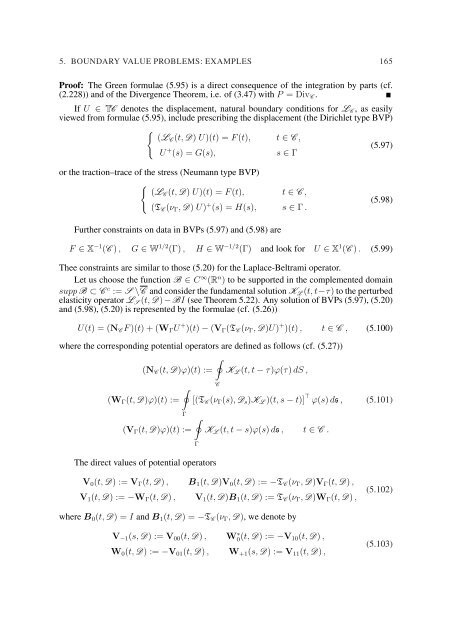EQUATIONS OF ELASTIC HYPERSURFACES
EQUATIONS OF ELASTIC HYPERSURFACES
EQUATIONS OF ELASTIC HYPERSURFACES
You also want an ePaper? Increase the reach of your titles
YUMPU automatically turns print PDFs into web optimized ePapers that Google loves.
5. BOUNDARY VALUE PROBLEMS: EXAMPLES 165<br />
Proof: The Green formulae (5.95) is a direct consequence of the integration by parts (cf.<br />
(2.228)) and of the Divergence Theorem, i.e. of (3.47) with P = Div C .<br />
If U ∈ TC denotes the displacement, natural boundary conditions for L C , as easily<br />
viewed from formulae (5.95), include prescribing the displacement (the Dirichlet type BVP)<br />
{<br />
(LC (t, D) U)(t) = F (t), t ∈ C ,<br />
(5.97)<br />
U + (s) = G(s),<br />
s ∈ Γ<br />
or the traction–trace of the stress (Neumann type BVP)<br />
{<br />
(LC (t, D) U)(t) = F (t), t ∈ C ,<br />
(T C (ν Γ , D) U) + (s) = H(s), s ∈ Γ .<br />
(5.98)<br />
Further constraints on data in BVPs (5.97) and (5.98) are<br />
F ∈ X −1 (C ) , G ∈ W 1/2 (Γ) , H ∈ W −1/2 (Γ) and look for U ∈ X 1 (C ) . (5.99)<br />
Thee constraints are similar to those (5.20) for the Laplace-Beltrami operator.<br />
Let us choose the function B ∈ C ∞ (R n ) to be supported in the complemented domain<br />
supp B ⊂ C c := S \C and consider the fundamental solution K L (t, t−τ) to the perturbed<br />
elasticity operator L S (t, D) − BI (see Theorem 5.22). Any solution of BVPs (5.97), (5.20)<br />
and (5.98), (5.20) is represented by the formulae (cf. (5.26))<br />
U(t) = (N C F )(t) + (W Γ U + )(t) − (V Γ (T C (ν Γ , D)U) + )(t) , t ∈ C , (5.100)<br />
where the corresponding potential operators are defined as follows (cf. (5.27))<br />
∮<br />
(N C (t, D)ϕ)(t) := K L (t, t − τ)ϕ(τ) dS ,<br />
∮<br />
(W Γ (t, D)ϕ)(t) :=<br />
C<br />
[(T C (ν Γ (s), D s )K L )(t, s − t)] ⊤ ϕ(s) ds , (5.101)<br />
Γ<br />
∮<br />
(V Γ (t, D)ϕ)(t) :=<br />
K L (t, t − s)ϕ(s) ds , t ∈ C .<br />
The direct values of potential operators<br />
Γ<br />
V 0 (t, D) := V Γ (t, D) , B 1 (t, D)V 0 (t, D) := −T C (ν Γ , D)V Γ (t, D) ,<br />
V 1 (t, D) := −W Γ (t, D) , V 1 (t, D)B 1 (t, D) := T C (ν Γ , D)W Γ (t, D) ,<br />
(5.102)<br />
where B 0 (t, D) = I and B 1 (t, D) = −T C (ν Γ , D), we denote by<br />
V −1 (s, D) := V 00 (t, D) , W ∗ 0(t, D) := −V 10 (t, D) ,<br />
W 0 (t, D) := −V 01 (t, D) , W +1 (s, D) := V 11 (t, D) ,<br />
(5.103)

















